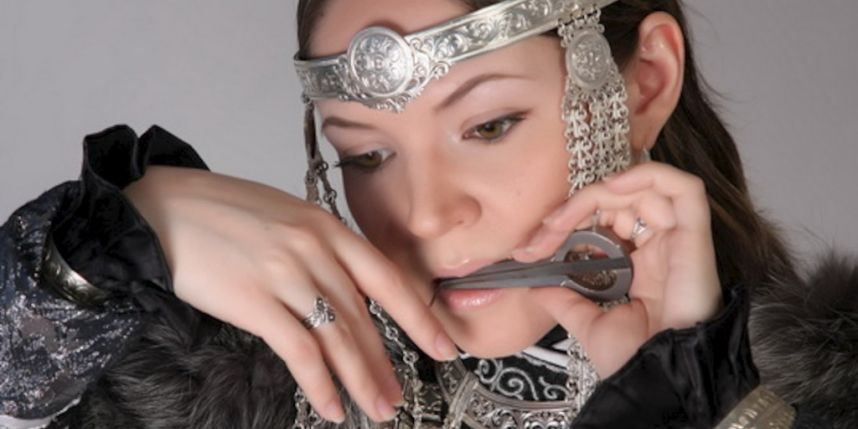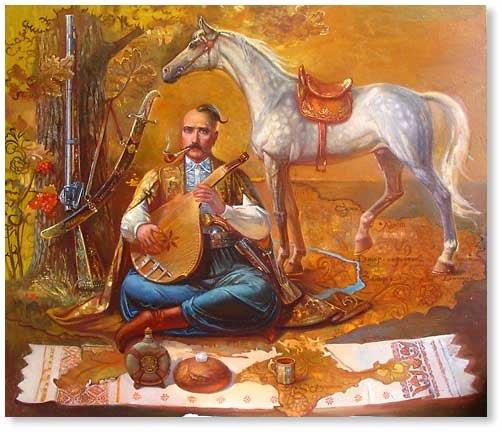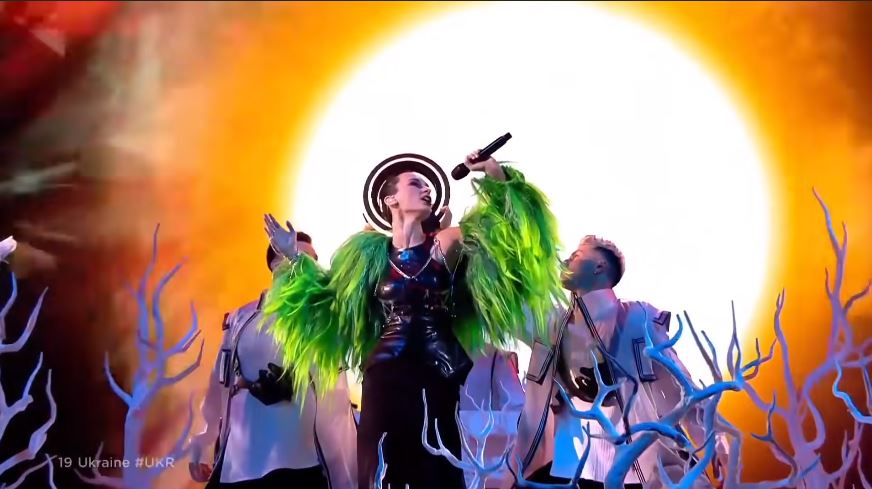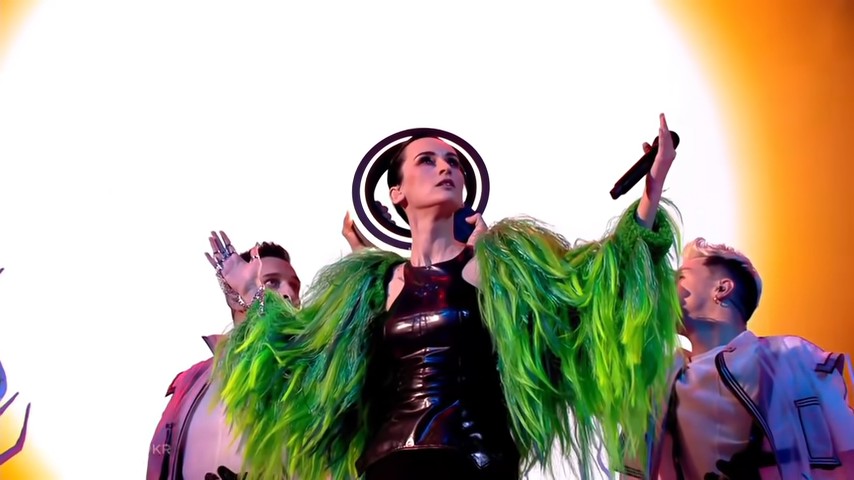- Stars of the Ukrainian folk scene: Go_A and DakhaBrakha
- Direct reconstruction with minimal arrangement
- Rock and Folk Metal
- Funny and celebratory folk songs
- Electro-arrangements of folk and chill folk music
- Powerful folk-songs
How Ukrainian folk became popular
Polyphonic folk singing was always a powerful tradition of Ukrainian melos. Ukrainian composers have found inspiration in folk songs since classic composers like Semen Hulak Artemovskyi and Mykola Lysenko. Renowned composers themselves recorded many folk songs, arranging them either for soloists or choirs. Not surprisingly, the first Ukrainian operas Taras Bulba and Cossack Beyond the Danube are also based on various folk motifs, both in melody and libretto, and both dedicated to the legacy of Ukrainian Cossacks.
Leontovych’s Shchedryk was also written as an arrangement of a folk song and later became internationally known when translated as Carol of the Bells. Modern-day Ukrainian composers widely use folk melodies. For example, Yevhen Stankovych (b. 1942) wrote the folk-opera Koly Tsvite Paporot (When the Fern Blooms) performed at the Lviv Theatre of Opera and Ballet in 2017. It had been banned in the USSR from the mid-70s ostensibly “for technical reasons.” Common knowledge was that the real reason for the ban was because of the uncensored interpretation of folklore. Such themes were not approved by the regime, especially when they were festive. The opera remains a repertoire favourite.

Since the 1960s, Ukrainian folk has permeated popular music. During the politic “Thaw” of the Khrushchev era when the regime softened its draconic measures, the Communist Party encouraged Soviet nations to perform folk songs and dances. The goal of their directive was to create a home-bred popular culture that would stop Western art from penetrating the regime. Artists in every field gladly leaped onto the opportunity, deliberately defying earlier party-prescribed sharovarshchyna – an artificial and pejorative interpretation of folk culture, effectively meant to demean the Cossack era. New creative bands emerged that mixed Western-style music with folk motifs. Folk music was performed in traditional folk attire, introducing modern rock and other cutting-edge music. These “folk” bands were modest, often consisting of two or three guitars, drums, as well as unique instruments that gave them a distinct sound.
When the party realized how far the trend had strayed from official policy, the music was banned. However, in the 1990s and especially after the 2014 Revolution of Dignity, a new wave of bands experimenting with folk songs emerged. These artists vary from creating meticulously precise reconstructions of 17th century baroque choral to newly composed songs with modern lyrics that are inspired by melodies of old and performed with little known, rare folk instruments dating from ancestral generations.
Stars of the Ukrainian folk scene: Go_A and DakhaBrakha
DakhaBrakha, formed in the early 2000s in the creative atmosphere of the Kyiv Dakh Theater, is a unique Ukrainian band both in its costuming and musical style. DakhaBrakha has so far given the largest number of concerts abroad, with much notoriety in the diaspora. Their name derives from the ancestral form of the Ukrainian words “give” and “take.” Thus, musicians themselves define the style of their music as “ethno chaos,” combining a cacophony of different ethnic variants. See DakhaBrakha’s remake of the folk song Plyve Choven (Floating Boat) which was used as a soundtrack for the 2019 Ukrainian film Volkano.
Go_A is a relatively new band, formed in 2012. In 2016, it won the Best Track in Ukraine competition and quickly skyrocketed to the international Eurovision contest. The band combines original Ukrainian folk songs with a unique electronic arrangement. Especially striking was the band’s music video of Shum (Rustle) — their Eurovision entry — a remake of an ancient pagan song that entices spring to arrive. Songs like this were known as vesnianky. The Shum video was filmed in the Chornobyl exclusion zone in a post-apocalyptic style, with a real-life embodiment of a vesnianka inducing spring out of the barren landscape and haunting desolation — even here renewed life is possible.
https://www.youtube.com/watch?v=U7-dxzp6Jvs
Direct reconstruction with minimal arrangement
Drevo takes its name from the antiquated word for tree. A Kyiv group, it was the first to usher in a new direction for the musical culture of Ukraine, demonstrating to the world that traditional folk music is an authentic, robust artistic phenomenon. Founded in 1979, the group was most active in the 1990s and 2000s. Drevo is highly appreciated for its contribution to folk, not only through performing, but by compiling and preserving folklore (YouTube, Soundcloud).
Chorea Kozatska (Cossacks’ Choir) was founded in 2005 in Kyiv. Predominantly reconstructing Ukrainian baroque music, they are also composing work from the medieval and classicist era using 16th to 18th century sheet music and authentic musical instruments. (YouTube)
The ancient song Vojska Zaporozhskoho Vojin Znamenytyi (Famous Warrior of the Zaporozhzhian Host) tells the story of a virtuous Cossack warrior defending Ukrainian lands:
Bozhychi is a choral ensemble created in 1999. The group is among those that reconstruct songs in open-throat polyphonic folk style. They also search out and document folk songs common to villages and recreate them in their unique form. Thanks to Bozhychi, many songs are being preserved that could otherwise be forgotten. (YouTube, AppleMusic, Soundcloud)
The ensemble describes this video as a reflection on the tragic events of the ongoing war in Donbas:
The following playlist is a collection of authentic polyphonic songs produced by Bozhychi.
Lemko Bluegrass Band. This Lemko band was established in 2012 and is known for regional Carpathian Mountain music. They mainly perform Lemko songs from the 19th and early 20th century using minimal arrangement. They not only perform solemn, patriotic, and religious music but their work includes simple, joyful renditions that entertain. (YouTube, Soundcloud, Reverbnation)
Khrystyna Soloviy gained notoriety when she entered a Ukrainian TV music contest in 2013, performing traditional Lemko folk songs. As the daughter of resettled Lemkos, she sings with great compassion for her people and, combined with her beautiful voice, she quickly rose in popularity. Her 2015 album Aqua Vita includes 11 folk songs arranged by Sviatoslav Vakarchuk — the renowned soloist with the famous Ukrainian rock band Okean Elzy. Her rendition of Pod Oblachkom (By the Window) is her best known, even though she has since recorded many of her own pop songs.
Navka is a folk project led by Maryna Tymofiychuk. She has been writing her own songs since the 2000s but recently started working with folk song videos, using her own arrangements while staying true to the original. Balancing video, arrangement and melody in her work is probably one of the best examples of how a folk song can find new life — not necessarily converting into a rock or pop adaptation — while at the same time tapping into a modern context. (YouTube, AppleMusic)

The Burdon Folk Band was launched in 2002. Their work is varied, mainly based on traditional melodies, ritualistic songs and ancient ballads. Much of their presentation includes folk dancing. Most songs are inspired by the regional traditions of Ukrainians living in the highlands of the Carpathians: Lemkos, Boykos and Hutsuls. The band performs with ancient instruments typical of these mountain communities – for example, the Drymba – underlaid with conventional string instruments, such as the violin and bass. The compelling vibration of the Drymba conveys an absorbing meditative tone. (YouTube, albums: 2006, 2008, 2013)
Rock and Folk Metal

Tin Sontsia (Sun’s Shadow) came on the scene in 1999, and is one of the first folk bands in Ukraine. Undeniably iconic, they can be credited with launching the folk trend. Their particular style blends traditional Ukrainian bandura with classic violin, and rock. In addition to using folk motifs, they write original lyrics echoing pagan gods and legends of patriotic heroes, as well as the courage of the Cossacks (YouTube, deezer, AppleMusic, Spotify, Soundcloud, albums: 2011, 2013, 2017, 2018, 2020).
For example, one of their most popular songs is Mech Areya about the legendary sword of Arey, pagan god of war. The song mirrors the Russo-Ukrainian war in Donbas with the ancient story of the sword that was gifted by the gods to Ukrainian warriors to protect their land. The piece culminates in the cry to present-day warriors: “And now it is you who are holding this magic sword.”
Veremiy is a Kyiv band which came together in 2002 and today focuses on melodic-heavy-folk. The band creates both modern Ukrainian rock as well as traditional folk-based songs. For the latter, they often collaborate with a Ukrainian band of kobzars, because their singing is accompanied by the string instrument bandura. For example, their piece Tykhyi Haj (Silent Grove) is about the far distant past “where remain today only temples covered by moss.” It depicts the story of a warrior who fought in battles far from his homeland and now he must forge his way home through treacherous swamps, forests and ravines. (YouTube, Soundcloud, AppleMusic)
Other songs are of mythical characters or spirits like Girl of the Lake and Kolyskova which adjures all misfortune to get away from the family and from the children living there. The band also produces modern songs like First Snow — a song seemingly about love, yet between the lines resonating the turbulent Maidan revolution of 2014.
Raj iz tvojih sniv (Paradise from Your Dreams) is another Ukrainian folk-metal band, founded in 2013 in Lviv. The band uses sopilkas (flute-like instruments), bagpipes (ed. not only native to Scotland) and other folk instruments. Their songs are full of metaphors, many evoking heroes from antiquity. Recently, the band released a video version of Pisnia Hir (Song of the Mountains) where a long-time traveller returns to his native Carpathians and, mesmerized by their majesty, experiences a personal reawakening (SoundCloud, Youtube).
Karna was formed in 1997 then changed its style radically in 2013 and went on to explore Hutsul or Carpathian Metal. Most of their work is dedicated to the majesty of the mountains and mountain dwellers whose very isolation lends itself to a distinctive sound. Like other bands, their musical tone is interpreted through today’s metal genre. The band’s style is best encapsulated by the cover of its 2017 album Hutsul. Depicting a caricature of a Hutsul in traditional dress bearing traditional Hutsul axes, it is jolting since the figure is depicted in gory metal, holding a disembodied infernal heart.
One of the band’s most popular songs is Malenka (Little One) about a distant star — a symbol of a young man’s love as he wanders through the frozen peaks imploring its beam to come alive in his hands.

Motanka is another mystical, folk-metal band. Founded in Lutsk in 2015, the band uses folk instruments, such as tsymbaly and ocarinas.
The name of the band originates from motanka dolls – wood-carved dolls that were not mere toys but conveyed mystery and magic. One of their most popular songs is Oy Ty Moia Zemle (Oh, My Native Land), speaking of the eternal love for one’s homeland. More metal than folk, Motanka performs wearing apparition-like folk wear. Their performances are presented with eerie staging, using motanka dolls, idolic totem poles and mystical characters to personify lyrics. Watch their video with English lyrics, and a live concert recording. The complete album of this mystical newcomer is provided here. (YouTube, Spotify)

Chur, another Ukrainian folk band — often described as pagan folk metal – write their own songs but stay close to the original folk style. They perform with traditional instruments such as tsymbaly or kolisna lira (mechanical string instrument) along with electric guitars. One of the band’s best-known old songs is Try Shliakhy (Three Paths). The song is based on an ancient myth about the choice of three paths to follow: the difficult and thorny path for warriors; the narrow and stony path for saints; and the wide-open path for those who have betrayed their ancestors. Chur are singing both in English and Ukrainian, their newest songs are on YouTube. (YouTube, bandcamp, mailchi)
https://www.youtube.com/watch?v=jhqSEa0-Y-0
Funny and celebratory folk songs
Rock-H, created in 2008, this folk band originates from the town of Mukachevo, Zakarpattia region. The name rokash in the Zakarpattia dialect means a crew of friends. The band performs original folk songs with original dialect lyrics, arranging it in a modern style. Most of the songs are humorous and entertaining. Since their 2015 split, the band members expanded their range to include different styles but did not abandon folk. (YouTube, other services)
Their signature song is based on the Shchedryk motif, but performed in dialect. Double entendres add humor: “Let’s meet in the rokash to sing and celebrate the New Year.”
One of the band’s most popular songs is Spivanochka, (Joyful Song): “I sing my Spivanochka while I’m near my mum. When I leave mum to start a grown-up life, I won’t sing anymore. But I will sing close to an independent girl. I will sing today, and don’t scold me, my mum.”
Joryj Kłoc (transliteration Yori Klots) is a Ukrainian folk-rock band from Lviv. The band was founded in 2008 as an electronic project mixing ancient songs and motifs (list of services).
They perform both entertaining animated songs like this one for Christmas Eve:
Vopli Vidopliassova is one of the first modern folk bands, formed in 1986. Their lead singer is vocalist Oleh Skrypka, known for his vigorous support of Ukrainian folk, especially as the producer of Ukraine’s most popular folk festival, Kraiina Mrii (Land of Dreams). (YouTube, Spotify, AppleMusic)
They have produced many songs during the last 30 years, but one of the most famous is Skrypka’s unique arrangement of Shchedryk, depicted here:
Electro-arrangements of folk and chill folk music

ONUKA was founded in 2013. The ONUKA (granddaughter) project is a tribute to the outstanding Ukrainian master of musical instruments Oleksandr Shlonchyk, grandfather of the ensemble soloist Natalia Zhyzhchenko.
“He made my first sopilka, taught me to play, and formed my understanding of our Homeland,” says Natalia.
Since childhood, she has played various folk instruments, beginning with the simple sopilka and progressing to the less-known ocarina. (YouTube, Apple Music, Spotify, vimeo, Soundcloud).
Their recent music video is named Zenith, and is dedicated to the “beauty of the world around us:”
The Doox was founded in 2014 and its musicians have their own unique style. They blend ancient folklore themes and regional melodies from around the world, with modern electro and rock motifs, actively using wind instruments. Doox songs are usually either the original folk or their own composition using typical ethnic motifs. Their work is typically about nature and often employs dialects. (YouTube, AppleMusic, Soundcloud, )
Huliajhorod’s name can be loosely translated as “town of parties.” The band was created in 2002 in the central-Ukraine town Kropyvnytskyi. Originally, they mostly toured with the aim of preserving Ukrainian folklore in the polyphonic style. However, in 2016 they launched an electro-folk project that melds folk lyrics and instruments with disco arrangements as in this album:(YouTube, Soundcloud, AppleMusic)
KRUTЬ / Maryna Kryt is a singer and bandurist, performing folk songs as well as her own original work. Kryt is rethinking the bandura as a folk instrument, which is usually accompanied by folk vocals (ed. the style was distorted during Soviet times, when bandurists had to sing in a classical manner). She sings bandura jazz and her piece Ia Dyvliusia v Tvoi Pereliakani Ochi (I Look into Your Frightened Eyes) uses lyrics from the celebrated Ukrainian poet Vasyl Symonenko. (YouTube, Soundcloud, AppleMusic)
Atmasfera, created in 2003, can also be considered a folk band, although not only producing work with Ukrainian motifs. The band uses both Ukrainian and Indian folk instruments, and sing in Ukrainian, English and Sanskrit, often defining themselves as a “Yoga Music Band.” Their songs include mantras and meditative elements, usually depicting the beauty of the world and paying homage to the gods. The band includes twin sisters, the daughters of Yuri Yaremchuk, a Ukrainian musician regarded as one of the best in improvisational jazz and avant-garde. (YouTube, Soundcloud, Spotify)
Powerful folk-songs
Voanerges (Greek: Sons of Thunder) is a Ukrainian ethno-fusion band, formed in Kyiv in 1998. They perform traditional carols and folk music, as well as their own original pieces. Their musical journey has led them to ritual songs of Kyivan Rus. The band reincarnates and restores Ukrainian and pan-Slavic folklore of antiquity. A recent piece tells the story of ancient Chumaks – people who travelled through Ukraine to the Black Sea in search of salt. The journey was treacherous and Chumaks were lauded for their bravery. (YouTube, Soundcloud)
Folknery is a band founded in 2008 by two artists and international travelers, Volodymyr Mulyar and Yaryna Kvitka. In 2014, they bicycled around the world and conducted expeditions throughout Ukraine. One of their most popular songs is Karchata. The meaning of this word from antiquity has been lost through the millennia, but the common belief is that it describes new sprouts springing from tree stumps, or alternatively, crow chicks … perhaps the renewal of life. Other songs unite (YouTube, bandcamp, AppleMusic, Soundcloud)
Read also:
- Why was Ukraine’s Eurovision performance by Go_A so mesmerizing?
- Ukraine’s Go_A makes it to Eurovision grand final with archaic pagan tune to awaken spring
- The secret of Kateryna Pavlenko, Ukraine’s enigmatic Eurovision singer
- How Ukrainian artists broke into the global art scene after the Euromaidan Revolution
- Ukraine’s 30: prominent Ukrainians who changed the country and the world. Part 1: Culture
- The three Ukrainian women breathing new life into ancient musical traditions
- Explosion of new Ukrainian music after introduction of protectionist language quotas
- Kyiv is becoming the world’s music video capital: 12 iconic clips
- Five things to know about the Eurovision song contest in Kyiv
- 8 shades of Jamala, Ukraine’s Eurovision contestant
- Crimea comes to Eurovision





